Strategy and Global Environment: Toyota Problems Analysis Report
VerifiedAdded on 2022/10/02
|6
|1337
|328
Report
AI Summary
This report analyzes the problems faced by Toyota in the years 2009 and 2010, focusing on the company's deviation from lean management principles. The report examines the impact of globalization, managerial decisions, and product quality issues on Toyota's brand image. It delves into the root causes of the crisis, including lack of effective management information systems, employee turnover, supplier issues, and changes in corporate strategy. The report highlights the importance of lean production, efficient HR practices, and value innovation programs in addressing these challenges. It explores how overconfidence, lack of technical skills, and failure to adhere to core values contributed to the decline in production and market share. The report concludes by suggesting solutions such as value innovation programs to reduce work pressure and manufacturing costs, and revive market growth.
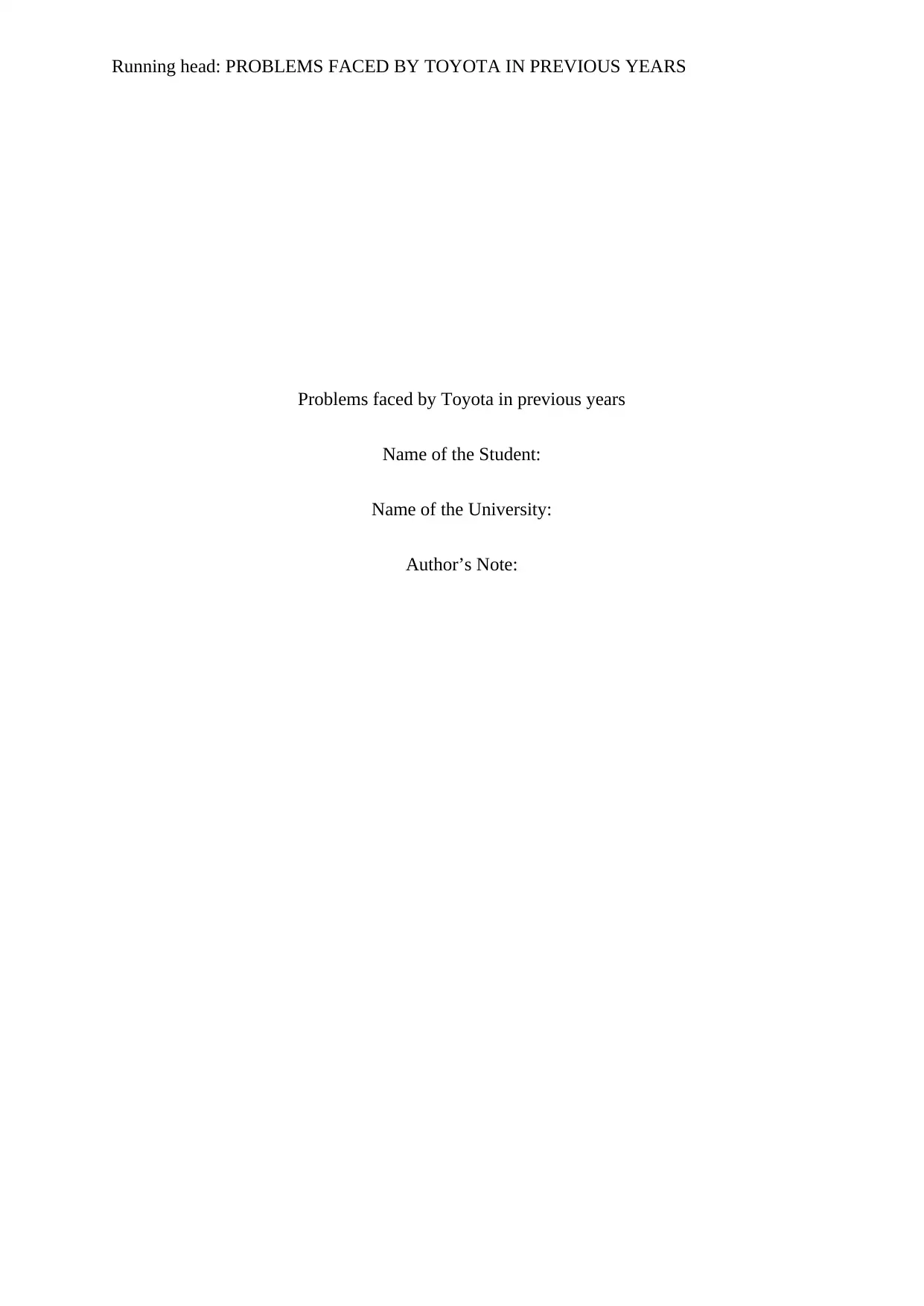
Running head: PROBLEMS FACED BY TOYOTA IN PREVIOUS YEARS
Problems faced by Toyota in previous years
Name of the Student:
Name of the University:
Author’s Note:
Problems faced by Toyota in previous years
Name of the Student:
Name of the University:
Author’s Note:
Paraphrase This Document
Need a fresh take? Get an instant paraphrase of this document with our AI Paraphraser
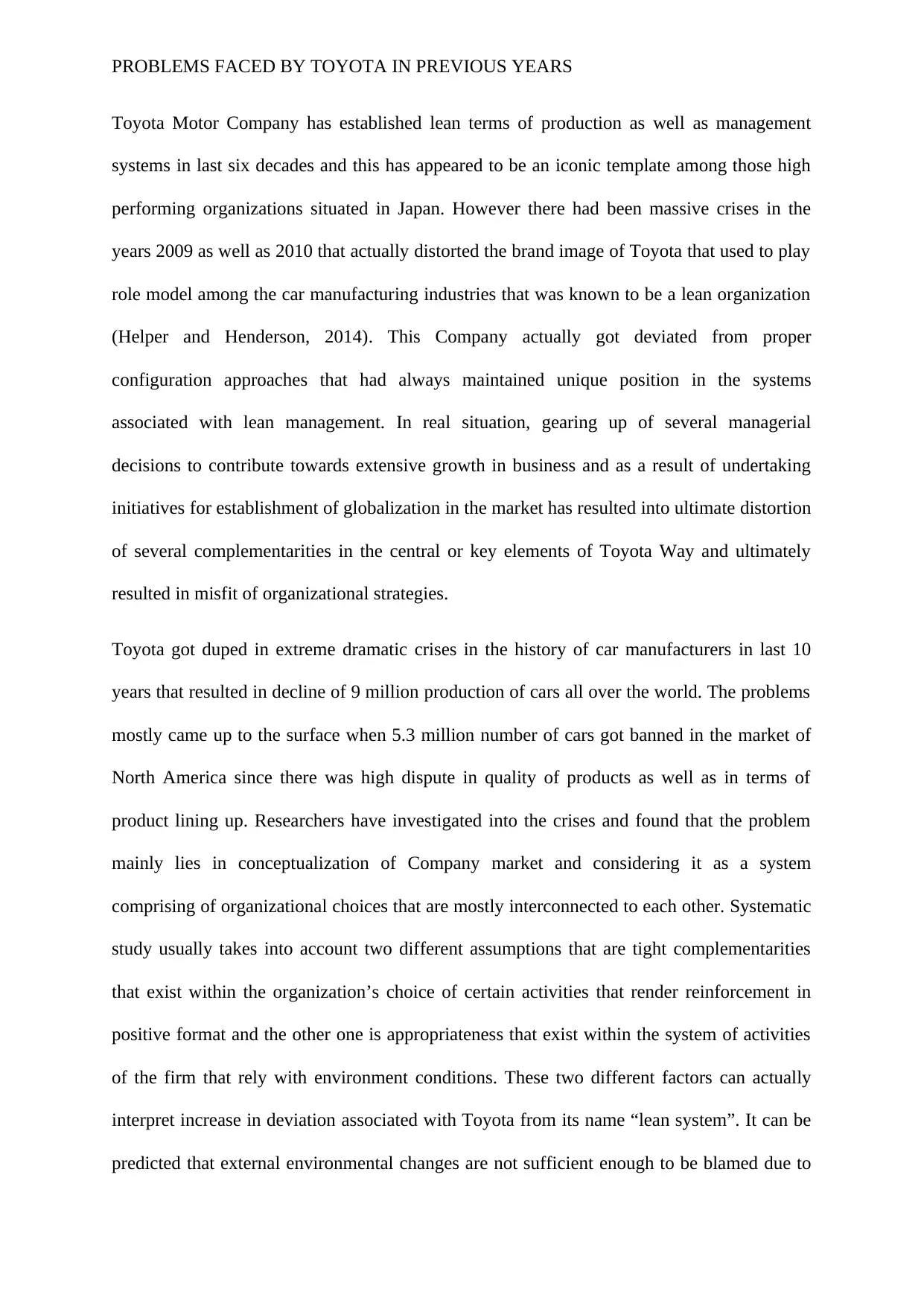
PROBLEMS FACED BY TOYOTA IN PREVIOUS YEARS
Toyota Motor Company has established lean terms of production as well as management
systems in last six decades and this has appeared to be an iconic template among those high
performing organizations situated in Japan. However there had been massive crises in the
years 2009 as well as 2010 that actually distorted the brand image of Toyota that used to play
role model among the car manufacturing industries that was known to be a lean organization
(Helper and Henderson, 2014). This Company actually got deviated from proper
configuration approaches that had always maintained unique position in the systems
associated with lean management. In real situation, gearing up of several managerial
decisions to contribute towards extensive growth in business and as a result of undertaking
initiatives for establishment of globalization in the market has resulted into ultimate distortion
of several complementarities in the central or key elements of Toyota Way and ultimately
resulted in misfit of organizational strategies.
Toyota got duped in extreme dramatic crises in the history of car manufacturers in last 10
years that resulted in decline of 9 million production of cars all over the world. The problems
mostly came up to the surface when 5.3 million number of cars got banned in the market of
North America since there was high dispute in quality of products as well as in terms of
product lining up. Researchers have investigated into the crises and found that the problem
mainly lies in conceptualization of Company market and considering it as a system
comprising of organizational choices that are mostly interconnected to each other. Systematic
study usually takes into account two different assumptions that are tight complementarities
that exist within the organization’s choice of certain activities that render reinforcement in
positive format and the other one is appropriateness that exist within the system of activities
of the firm that rely with environment conditions. These two different factors can actually
interpret increase in deviation associated with Toyota from its name “lean system”. It can be
predicted that external environmental changes are not sufficient enough to be blamed due to
Toyota Motor Company has established lean terms of production as well as management
systems in last six decades and this has appeared to be an iconic template among those high
performing organizations situated in Japan. However there had been massive crises in the
years 2009 as well as 2010 that actually distorted the brand image of Toyota that used to play
role model among the car manufacturing industries that was known to be a lean organization
(Helper and Henderson, 2014). This Company actually got deviated from proper
configuration approaches that had always maintained unique position in the systems
associated with lean management. In real situation, gearing up of several managerial
decisions to contribute towards extensive growth in business and as a result of undertaking
initiatives for establishment of globalization in the market has resulted into ultimate distortion
of several complementarities in the central or key elements of Toyota Way and ultimately
resulted in misfit of organizational strategies.
Toyota got duped in extreme dramatic crises in the history of car manufacturers in last 10
years that resulted in decline of 9 million production of cars all over the world. The problems
mostly came up to the surface when 5.3 million number of cars got banned in the market of
North America since there was high dispute in quality of products as well as in terms of
product lining up. Researchers have investigated into the crises and found that the problem
mainly lies in conceptualization of Company market and considering it as a system
comprising of organizational choices that are mostly interconnected to each other. Systematic
study usually takes into account two different assumptions that are tight complementarities
that exist within the organization’s choice of certain activities that render reinforcement in
positive format and the other one is appropriateness that exist within the system of activities
of the firm that rely with environment conditions. These two different factors can actually
interpret increase in deviation associated with Toyota from its name “lean system”. It can be
predicted that external environmental changes are not sufficient enough to be blamed due to
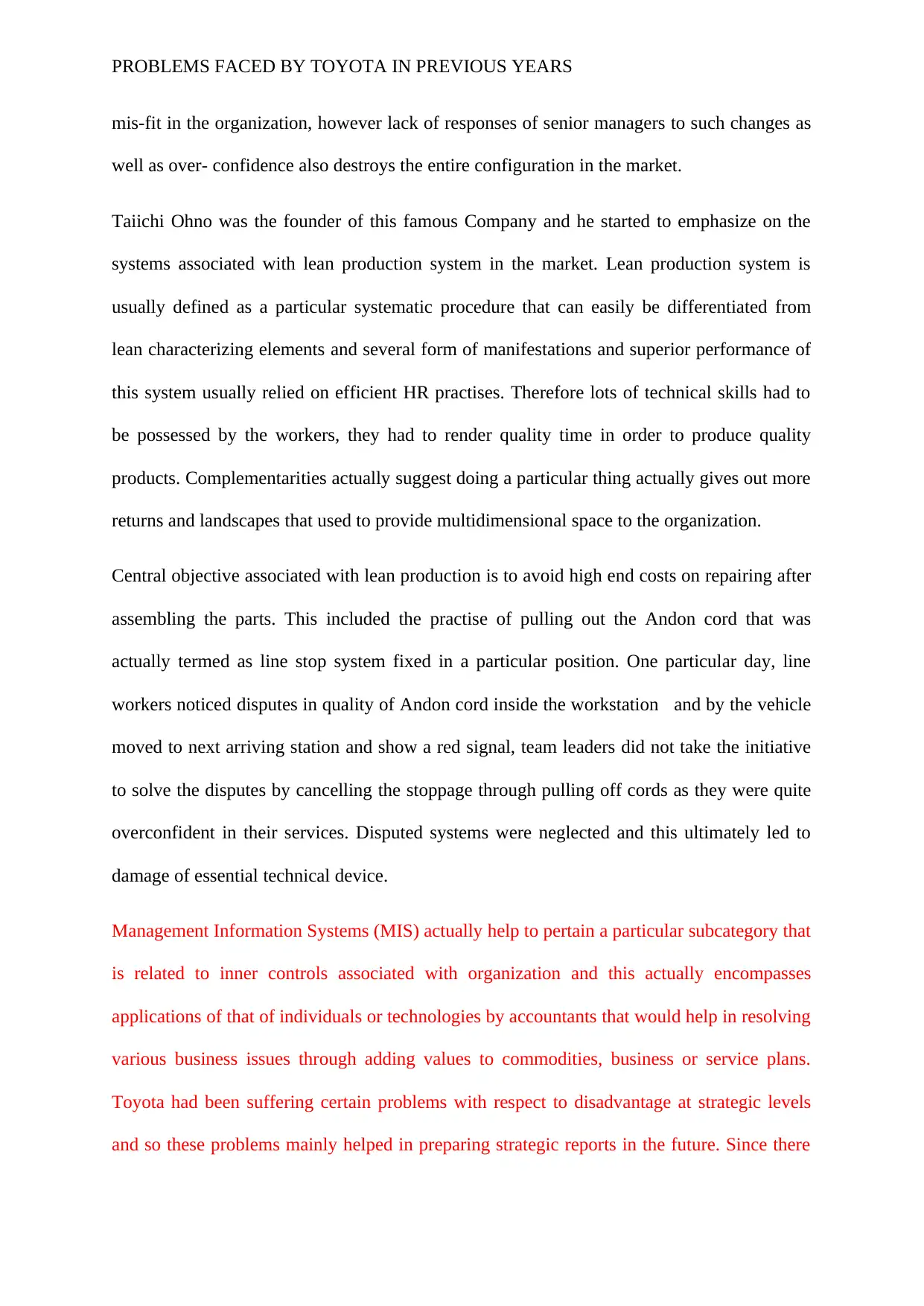
PROBLEMS FACED BY TOYOTA IN PREVIOUS YEARS
mis-fit in the organization, however lack of responses of senior managers to such changes as
well as over- confidence also destroys the entire configuration in the market.
Taiichi Ohno was the founder of this famous Company and he started to emphasize on the
systems associated with lean production system in the market. Lean production system is
usually defined as a particular systematic procedure that can easily be differentiated from
lean characterizing elements and several form of manifestations and superior performance of
this system usually relied on efficient HR practises. Therefore lots of technical skills had to
be possessed by the workers, they had to render quality time in order to produce quality
products. Complementarities actually suggest doing a particular thing actually gives out more
returns and landscapes that used to provide multidimensional space to the organization.
Central objective associated with lean production is to avoid high end costs on repairing after
assembling the parts. This included the practise of pulling out the Andon cord that was
actually termed as line stop system fixed in a particular position. One particular day, line
workers noticed disputes in quality of Andon cord inside the workstation and by the vehicle
moved to next arriving station and show a red signal, team leaders did not take the initiative
to solve the disputes by cancelling the stoppage through pulling off cords as they were quite
overconfident in their services. Disputed systems were neglected and this ultimately led to
damage of essential technical device.
Management Information Systems (MIS) actually help to pertain a particular subcategory that
is related to inner controls associated with organization and this actually encompasses
applications of that of individuals or technologies by accountants that would help in resolving
various business issues through adding values to commodities, business or service plans.
Toyota had been suffering certain problems with respect to disadvantage at strategic levels
and so these problems mainly helped in preparing strategic reports in the future. Since there
mis-fit in the organization, however lack of responses of senior managers to such changes as
well as over- confidence also destroys the entire configuration in the market.
Taiichi Ohno was the founder of this famous Company and he started to emphasize on the
systems associated with lean production system in the market. Lean production system is
usually defined as a particular systematic procedure that can easily be differentiated from
lean characterizing elements and several form of manifestations and superior performance of
this system usually relied on efficient HR practises. Therefore lots of technical skills had to
be possessed by the workers, they had to render quality time in order to produce quality
products. Complementarities actually suggest doing a particular thing actually gives out more
returns and landscapes that used to provide multidimensional space to the organization.
Central objective associated with lean production is to avoid high end costs on repairing after
assembling the parts. This included the practise of pulling out the Andon cord that was
actually termed as line stop system fixed in a particular position. One particular day, line
workers noticed disputes in quality of Andon cord inside the workstation and by the vehicle
moved to next arriving station and show a red signal, team leaders did not take the initiative
to solve the disputes by cancelling the stoppage through pulling off cords as they were quite
overconfident in their services. Disputed systems were neglected and this ultimately led to
damage of essential technical device.
Management Information Systems (MIS) actually help to pertain a particular subcategory that
is related to inner controls associated with organization and this actually encompasses
applications of that of individuals or technologies by accountants that would help in resolving
various business issues through adding values to commodities, business or service plans.
Toyota had been suffering certain problems with respect to disadvantage at strategic levels
and so these problems mainly helped in preparing strategic reports in the future. Since there
⊘ This is a preview!⊘
Do you want full access?
Subscribe today to unlock all pages.

Trusted by 1+ million students worldwide
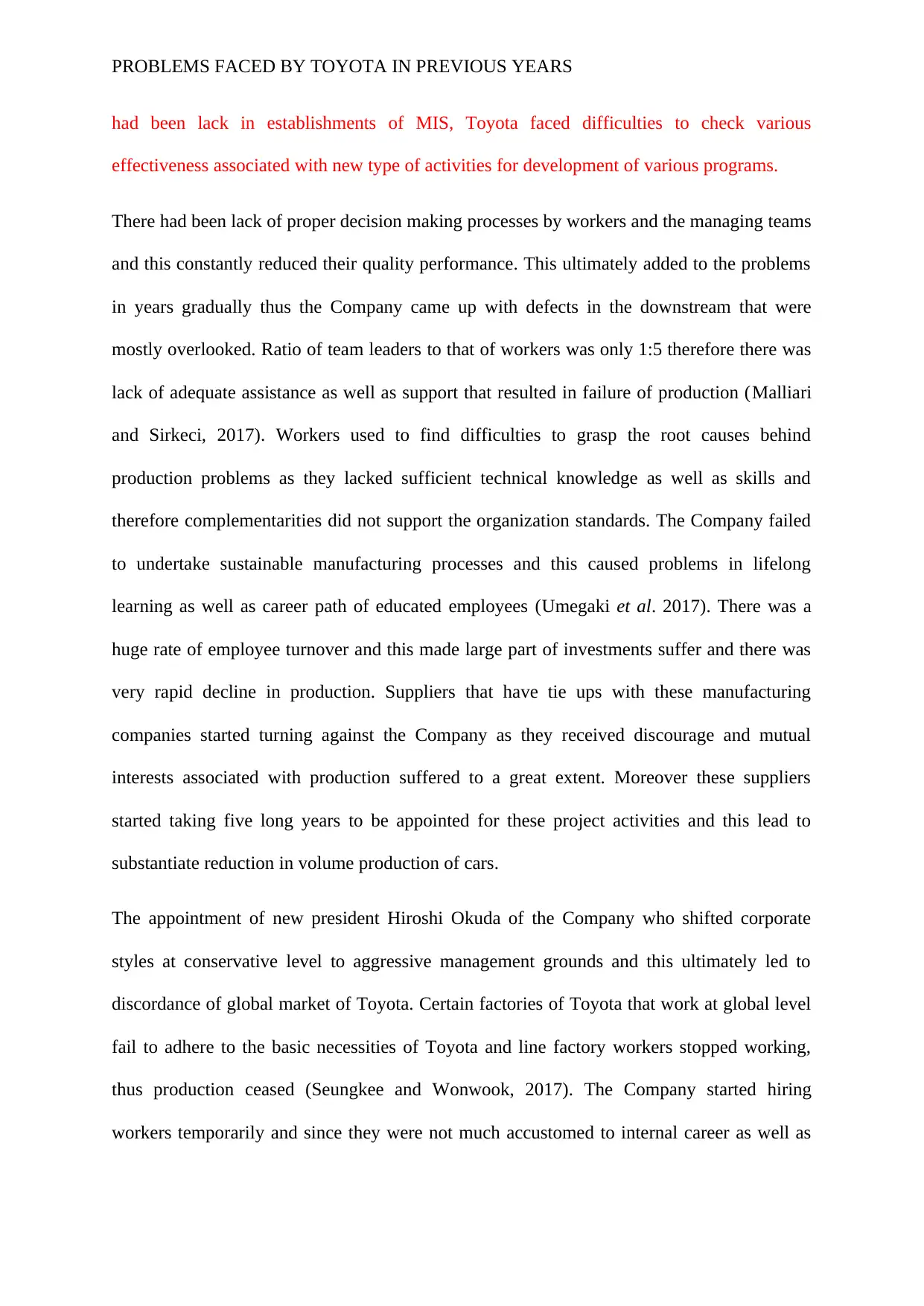
PROBLEMS FACED BY TOYOTA IN PREVIOUS YEARS
had been lack in establishments of MIS, Toyota faced difficulties to check various
effectiveness associated with new type of activities for development of various programs.
There had been lack of proper decision making processes by workers and the managing teams
and this constantly reduced their quality performance. This ultimately added to the problems
in years gradually thus the Company came up with defects in the downstream that were
mostly overlooked. Ratio of team leaders to that of workers was only 1:5 therefore there was
lack of adequate assistance as well as support that resulted in failure of production (Malliari
and Sirkeci, 2017). Workers used to find difficulties to grasp the root causes behind
production problems as they lacked sufficient technical knowledge as well as skills and
therefore complementarities did not support the organization standards. The Company failed
to undertake sustainable manufacturing processes and this caused problems in lifelong
learning as well as career path of educated employees (Umegaki et al. 2017). There was a
huge rate of employee turnover and this made large part of investments suffer and there was
very rapid decline in production. Suppliers that have tie ups with these manufacturing
companies started turning against the Company as they received discourage and mutual
interests associated with production suffered to a great extent. Moreover these suppliers
started taking five long years to be appointed for these project activities and this lead to
substantiate reduction in volume production of cars.
The appointment of new president Hiroshi Okuda of the Company who shifted corporate
styles at conservative level to aggressive management grounds and this ultimately led to
discordance of global market of Toyota. Certain factories of Toyota that work at global level
fail to adhere to the basic necessities of Toyota and line factory workers stopped working,
thus production ceased (Seungkee and Wonwook, 2017). The Company started hiring
workers temporarily and since they were not much accustomed to internal career as well as
had been lack in establishments of MIS, Toyota faced difficulties to check various
effectiveness associated with new type of activities for development of various programs.
There had been lack of proper decision making processes by workers and the managing teams
and this constantly reduced their quality performance. This ultimately added to the problems
in years gradually thus the Company came up with defects in the downstream that were
mostly overlooked. Ratio of team leaders to that of workers was only 1:5 therefore there was
lack of adequate assistance as well as support that resulted in failure of production (Malliari
and Sirkeci, 2017). Workers used to find difficulties to grasp the root causes behind
production problems as they lacked sufficient technical knowledge as well as skills and
therefore complementarities did not support the organization standards. The Company failed
to undertake sustainable manufacturing processes and this caused problems in lifelong
learning as well as career path of educated employees (Umegaki et al. 2017). There was a
huge rate of employee turnover and this made large part of investments suffer and there was
very rapid decline in production. Suppliers that have tie ups with these manufacturing
companies started turning against the Company as they received discourage and mutual
interests associated with production suffered to a great extent. Moreover these suppliers
started taking five long years to be appointed for these project activities and this lead to
substantiate reduction in volume production of cars.
The appointment of new president Hiroshi Okuda of the Company who shifted corporate
styles at conservative level to aggressive management grounds and this ultimately led to
discordance of global market of Toyota. Certain factories of Toyota that work at global level
fail to adhere to the basic necessities of Toyota and line factory workers stopped working,
thus production ceased (Seungkee and Wonwook, 2017). The Company started hiring
workers temporarily and since they were not much accustomed to internal career as well as
Paraphrase This Document
Need a fresh take? Get an instant paraphrase of this document with our AI Paraphraser

PROBLEMS FACED BY TOYOTA IN PREVIOUS YEARS
training processes, it harmed execution of various decentralized rights and thus irregularities
aroused in work processes.
These problems can be solved through Value- Innovation programs that were undertaken by
the Company in between the years 2005 to that of 2009, as this would ultimately reduce work
pressure, reduce high prices with respect to manufacturing and this would be able to revive
growth in the market in coming years.
training processes, it harmed execution of various decentralized rights and thus irregularities
aroused in work processes.
These problems can be solved through Value- Innovation programs that were undertaken by
the Company in between the years 2005 to that of 2009, as this would ultimately reduce work
pressure, reduce high prices with respect to manufacturing and this would be able to revive
growth in the market in coming years.
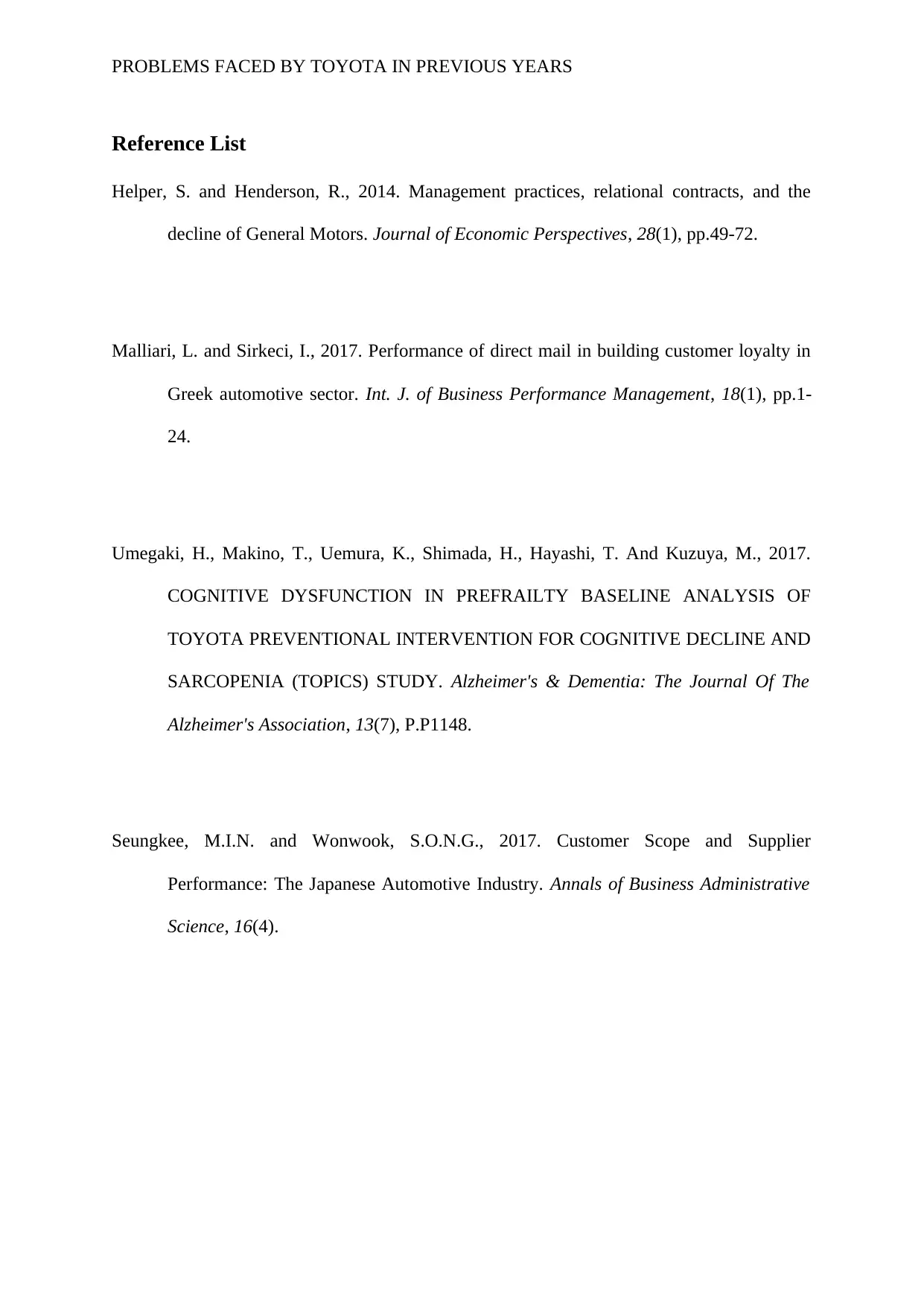
PROBLEMS FACED BY TOYOTA IN PREVIOUS YEARS
Reference List
Helper, S. and Henderson, R., 2014. Management practices, relational contracts, and the
decline of General Motors. Journal of Economic Perspectives, 28(1), pp.49-72.
Malliari, L. and Sirkeci, I., 2017. Performance of direct mail in building customer loyalty in
Greek automotive sector. Int. J. of Business Performance Management, 18(1), pp.1-
24.
Umegaki, H., Makino, T., Uemura, K., Shimada, H., Hayashi, T. And Kuzuya, M., 2017.
COGNITIVE DYSFUNCTION IN PREFRAILTY BASELINE ANALYSIS OF
TOYOTA PREVENTIONAL INTERVENTION FOR COGNITIVE DECLINE AND
SARCOPENIA (TOPICS) STUDY. Alzheimer's & Dementia: The Journal Of The
Alzheimer's Association, 13(7), P.P1148.
Seungkee, M.I.N. and Wonwook, S.O.N.G., 2017. Customer Scope and Supplier
Performance: The Japanese Automotive Industry. Annals of Business Administrative
Science, 16(4).
Reference List
Helper, S. and Henderson, R., 2014. Management practices, relational contracts, and the
decline of General Motors. Journal of Economic Perspectives, 28(1), pp.49-72.
Malliari, L. and Sirkeci, I., 2017. Performance of direct mail in building customer loyalty in
Greek automotive sector. Int. J. of Business Performance Management, 18(1), pp.1-
24.
Umegaki, H., Makino, T., Uemura, K., Shimada, H., Hayashi, T. And Kuzuya, M., 2017.
COGNITIVE DYSFUNCTION IN PREFRAILTY BASELINE ANALYSIS OF
TOYOTA PREVENTIONAL INTERVENTION FOR COGNITIVE DECLINE AND
SARCOPENIA (TOPICS) STUDY. Alzheimer's & Dementia: The Journal Of The
Alzheimer's Association, 13(7), P.P1148.
Seungkee, M.I.N. and Wonwook, S.O.N.G., 2017. Customer Scope and Supplier
Performance: The Japanese Automotive Industry. Annals of Business Administrative
Science, 16(4).
⊘ This is a preview!⊘
Do you want full access?
Subscribe today to unlock all pages.

Trusted by 1+ million students worldwide
1 out of 6
Your All-in-One AI-Powered Toolkit for Academic Success.
+13062052269
info@desklib.com
Available 24*7 on WhatsApp / Email
![[object Object]](/_next/static/media/star-bottom.7253800d.svg)
Unlock your academic potential
Copyright © 2020–2025 A2Z Services. All Rights Reserved. Developed and managed by ZUCOL.